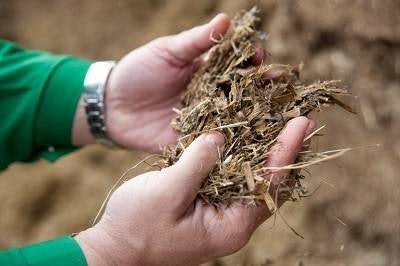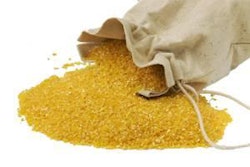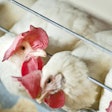
With the increased usage of byproducts in animal feed comes the added risk of bacterial and mycotoxin contamination; however, the mindful preservation of these ingredients is the key to reducing troublesome conditions, increasing the benefits for the animal and bringing extra profits for the producer. Naturally, the use of high-quality raw materials in feed is the basis for good health. While every organic material has a natural (epiphytic) microflora, which grows on the surface and is gradually replaced by storage microorganisms, the goal of feed preservation is to inhibit the growth of organisms that lower animal performance, result in loss and contamination.
According to the Food and Agriculture Organization (FAO), 25 percent of the world’s annual crop is contaminated with mycotoxins. The high availability of nutrients in byproducts – coupled with relatively high moisture content – stimulates the growth of molds, yeasts and bacteria. These organisms are responsible for quantitative losses of high nutrient and energy content as well as the qualitative issues related to the formation of undesirable substances.
Historically, the use of chemicals (acids and their salts) in feed conservation is a tried-and-true method used to protect stored feed and byproducts from bacterial, mold and yeast contamination. This article provides research to support how the use of propionic acid and sodium benzoate preservative products can reduce the risk of feed contamination and improve profits.
Byproduct usage in animal feeding
The food, beverage and fermentation industries produce a large volume of wet, liquid and/or moist byproducts, which are often used as a cheaper alternative to traditional feedstuffs in animal feeding. Recycling these byproducts contributes to a more sustainable production chain and aids in maintaining a high level of animal production by contributing protein and energy in the feed.
Since byproducts come from various origins their quality should be questioned. The high water content of nutrient-rich byproducts results in the perfect conditions for molds, yeast and bacteria growth, which are destructive to an animal’s performance.
In order to overcome some relatively common problems in field conditions (i.e. the growth of molds on the top of wrapped silage, short aerobic stability, dry matter and energy losses, etc.), the use of a preservative is fully justified. In this way, the degradation processes no longer occurs. For example, with preservation, the organoleptic characteristics of ensilaged beet pulp can be maintained for one to two years.
Silage treatment
The usage of bacterial inoculants is widely accepted to improve the feed quality of silage. Under circumstances where it may be difficult to preserve silage or where there is insufficient silage management, feed quality can be poor even when inoculants are used. In these situations, a preservative based on a blend of propionic acid and sodium benzoate should be used to treat the entire silo or at least the upper layer, as this area is most vulnerable to aerobic deterioration. In the feed-out-phase, the freshly cut layer that comes in contact with the air should also be treated with a preservative, reducing the oxidative processes. Treating the silage to ensure its hygiene can prevent the growth of molds (mycotoxins), yeasts (alcohol) and bacteria (Clostridia).Wet Distillers Grains with Solubles Wet Distillers Grains with Solubles (WDGS) is also a perfect substrate in which microorganisms can grow and multiply very easily. Therefore, a preservative is needed to ensure a high-quality feed byproduct. Such a preservative should be mixed directly in at the ethanol plant after decanting for a homogenous mix, which guarantees all particles come into contact with the product.
Tests have been conducted to determine the effect of a blend of propionic acid and sodium benzoate liquid on the stability of WDGS under aerobic conditions. WDGS (30 percent dry matter) was stored for seven days under aerobic conditions. A preservative blend of propionic acid and sodium benzoate was applied in the recommended dosages by spraying on the byproduct, then homogenously mixing it.
Results showed the pH level increased from the original value of 5 to 7.0. Within 90 to 168 hours, the pH reached a level of 8.5 to 8.7. The treated byproduct with three-to-one ratio of preservative/ton did not surpass a pH value of 6.7 in the same period of time (Figure 1).
Additionally, dry matter losses were significantly reduced by adding a preservative (Figure 2), showing the preservative had a positive effect on the quality of the stored byproduct.
In conclusion, the test clearly showed that the usage of preservatives in WDGS increased the stability of the byproduct while reducing dry matter losses.
Brewer’s grain preservation
Preservation of brewer’s grains is very difficult because its high water and protein content make it an ideal living environment for pathogens. Preservatives can increase the storage time of brewer’s grains and reduce the energy losses compared to non-treated byproducts. Tests have been conducted to determine the differences in the energy content of brewer’s grains when a blend of propionic acid and sodium benzoate is used for aerobic preservation. Differences in the energy content were found when preservatives were used (Figure 3) proving the economic advantages of the preservative to stabilize brewer’s grain under aerobic conditions.
Even with the lowest price/kilogram of body weight (€ 1.00), the use of the preservative to avoid energy losses would mean a profit per ton of € 1.26. If prices/kilogram body weight increased from € 1.00 to € 1.40, profit will increase proportionally and linearly from € 1.26 to € 3.87 (Figure 4).
Quality considerations
High moisture content combined with the high nutrient level of byproducts often results in the growth of bacteria, mold and yeast, which are harmful for the animal and decrease performance. Preservation products have been shown to maintain a low pH in the feed for a longer period of time, impeding the growth of pathogens while giving the feed and byproducts a better hygiene status. Even with low meat prices, preservation products are profitable when feedstuffs are challenged by microbial degradation.
For more information on preservation products using propionic acid and sodium benzoate blends, such as Biomin’s CleanGrain, please visit the company’s website, www.biomin.net.














